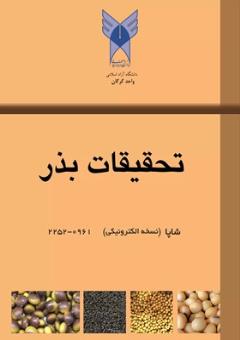بررسی خصوصیات جوانهزنی بذر و تعیین دماهای کاردینال گیاه دارویی هندوانه ابوجهل (Citrullus colocynthis)
محورهای موضوعی : فیزیولوژی و متابولیسم بذر
1 - گروه زراعت و اصلاح نباتات، واحد سبزوار، دانشگاه آزاد اسلامی، سبزوار، ایران
2 - استادیار دانشگاه آزاد اسلامی، واحد سبزوار، گروه زراعت و اصلاح نباتات
کلید واژه: سرعت جوانهزنی, هندوانه ابوجهل, دمای بیشینه, دماهای کاردینال,
چکیده مقاله :
هندوانه ابوجهل یکی از گیاهان دارویی مهم در طب سنتی میباشد که عمدتاً در مناطق خشک و بیابانی رشد میکند و تاکنون تحقیقات چندانی پیرامون دماهای کاردینال آن انجام نشدهاست. بهمنظور بررسی خصوصیات جوانهزنی بذر و تعیین دماهای کاردینال این گیاه مطالعهای در شرایط آزمایشگاهی صورت گرفت. بدین منظور آزمایشی در 9 دمای ثابت 5، 10، 15 ،20 ،25 ،30، 35، 40، و 45 درجه سانتیگراد در پتری دیش در قالب طرح کاملاً تصادفی و با 4 تکرار اجرا شد. صفات مورد اندازهگیری عبارت بودند از: درصد جوانهزنی، سرعت جوانهزنی و میانگین زمان جوانهزنی. دمای کاردینال با استفاده از توابع دندان مانند، دوتکهای و بتا محاسبه شد. نتایج نشان داد با افزایش دما تا 30 درجه سانتیگراد درصد و سرعت جوانهزنی افزایش یافت. بیشترین درصد جوانه زنی بذر(70 درصد) و سرعت جوانه زنی(8/2 عدد بذر/روز) در دمای 30 درجه سانتی-گراد مشاهده شد. کمترین زمان جوانه زنی بذر (48/4 روز) نیز در دمای 30 درجه مشاهده گردید. دمای پایه، مطلوب و بیشینه این گیاه به ترتیب 12، 30 و 45 درجه سانتیگراد میباشد.
Bitter apple (Citrullus colocynthis) is one of the medicinal plant that grows in semi-arid and desert condition which have been used in traditional medicine. There is a few research on cardinal temperatures of Bitter apple in the literature. In order to determine Germination characteristics and cardinal temperatures for Bitter apple, a laboratory experiment was down in petri dish based on completely randomized design with four replications. The experimental treatments were nine different temperatures (5, 10, 15, 20, 25, 30, 35, 40, 45 °c). The measured traits were germination percentage, germination rate and mean germination time. Cardinal temperature was calculated using dental, dual, and beta functions. The results showed that with increasing temperature up to 30 ° C, percentage and germination speed increased. The highest germination percentage (70%) and germination rate (2.8 seeds / day) were observed at 30 ° C. The lowest germination time (4.48 days) was observed at 30°C. The base, favorite and maximum temperatures (cardinal temperatures) for this plant were12, 30 and 45 °c, respectively.
Adam, N.R., Dierig, D.A., Coffelt, T.A. and Wintermeyer, M.J. 2007. Cardinal temperatures for germination and early growth of two Lesquerella species. Industrial Crops and Products, 25: 24-33.
Alipoor, Z. and Mahmodi, S. 2016. Determination of cardinal temperatures and respons of Securigera securidaca L. to different temperatures of germination. Iranian Journal of Seed Research, 2(2) :137-147.
Bannayan, M., Najafi, F., Rastgoo, M. and Tabrizi, L. 2006. Germination properties of some wild medicinal plants from Iran. Journal Seed Technology, 28: 80-86.
Ghahraman, A., 1991. Color Flora of Iran. Research Institute of Forests and Rangelands Publications. Botany Department. Tehran.
Jami Al-Ahmadi, M. and Kafi, M. 2007. Cardinal temperatures for germination of Kochia scoparia L. Journal of Arid Environments, 68: 308-314.
Kamkar, B. Zolfagharnejad, H. Khalili, N. 2015. Quantifying of germination rate response to temperature of three sunflower varieties using nonlinear regression models. Journal of Plant Production, 22(2): 119-136.
Kherikhah, M., Koochaki, A., Rezvani Moghaddam, P. and Nassiri Mohallati, M.2013. Determination of Cardinal Temperature of seed germination of Zizphora (Ziziphora clinopodioides) as a medicinal plant. Iranian Journal of Field Crops Research, 11(49): 543-550.
Koochaki, A., Azizi, G. 2005. Effect of different treatments on breaking dormancy of Teucrium polium. Iranian Journal of Field Crops Research, 3(1):81-88.
Kurtar, E.S. 2010. Modelling the effect of temperature on seed germination in some cucurbits. African Journal of Biotechnology, 9(9): 1343-1353.
Latifi, N., Soltani, A., and Spanner, D. 2004. Effect of temperature on germination components in Canola cultivars. Iranian, J. Agric. Sci., 35(2): 313-321.
Milani, E., Seyed, M., Razavi, A., Koocheki, A., Nikzadeh,V., Vahedi, N. and GholamhosseinPour, A. 2007. Moisture dependentphysical properties of cucurbit seeds. International Agrophysics, 21: 157-168.
Mozaffarian, v. 2000. Flora Yazd. Yazd Publishing. Yazd.
Najafi, F., Koocheki, A., Rezvani Moghaddam, P. and Rastgoo, M. 2007. Evaluation of seed germination characteristics in Nepeta binaludensis, a highly endangered medicinal plant of Iran. Iranian Journal of Field Crops Research, 4(2): 385-392.
Nerson, H. 2007. Seed production and germinability of cucurbit crops. Seed Science and Biotechnology, 1: 1-10.
Nozarpour, E., Tavakkol Afshari, R., Elias Soltani, E. and Majnoun Hosseini, N. 2016. Determination of cardinal temperatures of lemon balm (Melissa officinalis L.) seeds in response to temperatures and water potentials. Iranian Journal of Crop Sciences, 47(3): 341-351.
Portoosi, N., Rashed Mohasel, M. H. and Ezadi Darbandi, E. 2008. Germination characteristics and cardinal temperatures of lambsquarter, purselane and crabgrass. Iranian Journal of Field Crops Research, 6(2): 255-361.
Ranjbar, f., koocheki, A., Nassiri Mahalati, M. and kamayestani, n. 2013. Cardinal temperatures and germination properties of fennel (foeniculum vulgar). Seed research, 3(3): 61-68.
Salk, A., Arın, L., Deveci, M., and Polat, S .2008. Special vegetable growing. In Turkish, Tekirdag, p.488, ISBN 978-9944-0786-0-3.
Sarmadnia, Gh.H. and koochaki, A. 2007. Plant physiology. Publications Jahad Daneshgahi Mashhad.400pp.
Soltani, E., Galeshi, S., Kamkar, B. and Akram-Ghaderi, F. 2008. Modeling seed aging effects on the response of germination to temperature in wheat. Seed Science and Biotechnology, 2, 32-36.
Zangoie, M., Parsa, S., Mahmoodi, M. and Jami Al-Ahmadi, M. 2012. Evaluation of cardinal temperature for germination of asafoetida (Ferula assafoetida L.) seeds. J. of Plant Production, 19(3): 193-202.
Zeinali, E., Soltani, A., Galeshi, S., and Sadati, S.J. 2001. Cardinal temperatures, response to temperature and range of thermal tolerance for seed germination in wheat (Triticum aestivum L.) cultivars. J. Plant Prod., 3(3): 23-42.


